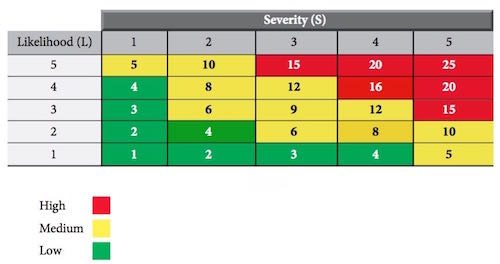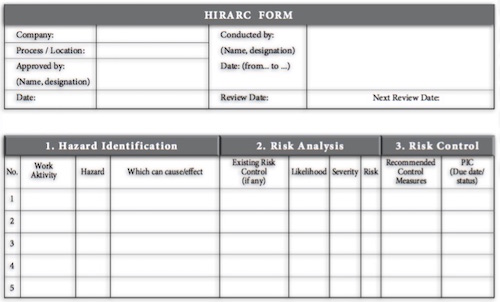Chemical Safety - Chemical substance that is safe to use if handled properly according to the rules. Generally, people consider chemicals as a harmful substance, and feared. This comes from lack of understanding about the handling of chemicals. So unfortunately there are also students or employees who are brave to use and handle chemicals recklessly and ignoring the dangers. This attitude is not only lead to all problems or accidents to themselves, but also to other students or employees.

Classification of Chemicals
Classification of chemicals is a general pattern based on physical hazards and chemical activity of the materials. This meant that proper safety precautions to be taken when handling chemicals to minimize the risk of accidents that may arise. Handling chemical substances refers to the acceptance, transmission, storage, use or disposal of waste. Anyone who handle chemicals must have knowledge of chemical safety signs and types of hazards that are labeled.
Explosives chemical safety signs
Class 1 - Explosives
This material is extremely dangerous and should be handled with caution. In storage must be in place separated from other materials and environment must be controlled especially in the heat.
Gases chemical safety signs
Gases chemical safety signs
Class 2 - Gases
Gas filled in steel cylinders usually at high pressure. There is also a form of liquid gas at low temperatures such as nitrogen. For the purpose of storage and use, gas is divided into three subclasses
They are:
- Flammable gas
- Unburned gas
- Poison gas
Flammable liquid chemical safety sign
Class 3 - Flammable Liquid
The liquid in this class is capable of producing a flammable vapour at temperatures below 61 C (142 F). However, there are also flammable liquids which are included in other classes because of toxicity and corrosive nature. Liquid in class 3 were sub-classified further based on the temperature level is flammable, so handling and storage can be done more carefully. Subclasses are:
Class 4 - Flammable Solids
The material in this class of compounds have been identified, including apparently seem harmless, but if the wrong operation, will be very dangerous. Subclasses that are used are:
- Flammable solids. The materials in this class are flammable and can be caused by external sources such as sparks or flames. Examples of flammable solids are cotton, sulphur and rubber materials.
- Solid likely to spontaneously combust. This material will ignite spontaneously when exposed to heat, water or moist air. Fire this material may produce toxic gases. Solid examples of this subclass are coal, plastics and ferric oxide.
- Solid hazardous when wet. The material in this subclass emit gases that not only flammable, but also toxic when exposed to water.
- Examples of this class of materials is calcium carbide, aluminium powder and calcium derivatives, lithium, magnesium-based compounds, compounds based on potassium, rubidium, sodium and zinc.
Oxidizer and organic peroxides chemical safety signs
Class 5 - Oxidizers and Organic Peroxides Materials
The class is divided into two subclasses, namely:
- Oxidation agents. These substances give off oxygen in the fire and cause difficulty in controlling the fire. Some of the materials in this class are sensitive to impact, friction or heat buildup. There is also a material that reacts with moist air. The mixing of this material with a combustible organic material will produce a mixture of easily ignited and burn with the explosion. Uncontrolled reaction also occurs between the most powerful oxidising agent with acid will produce poisonous gas. An example of this is the fertiliser ammonium nitrate, chlorate, calcium and potassium permanganate.
- Organic peroxides. As well as oxidising agents, this material may decompose to produce oxygen and explosion. Most will burn rapidly and are sensitive to the heat, impact and friction. To reduce the danger, the material is usually conducted in the form of a wet paste with water or inert solids. Though, in this case it still may react out of control in the presence of trace impurities such as acids, metal oxides or amines. Decomposition that may be caused by heat rise will lead to an explosion and release of toxic or flammable gases.
Poisonous and infectious material chemical safety signs
Class 6 - Poisonous or Infectious Materials
The class is divided into two subclasses, namely:
- Poisonous substances. In general, the material in this class will cause harm or possibly death if swallowed, inhaled or absorbed through contact with the skin. Examples are pesticides and herbicides.
- Infectious material. The material in this subclass includes micro-organisms or toxins of the material that has been shown to produce disease in animals and humans.
Class 7 - Radioactive Materials
Chemicals Grade 7 refers to radioactive material. Please refer to Safety of Ionizing Radiation entry post.
Class 8 - Corrosive Materials
The material in this class can injure tissue and cause damage to other materials. Most of these produce malodorous vapours, toxic, hazardous and flammable. The reaction of this substance with water may produce gas and heat, which can increase the corrosion.
Grade 9 - Other Hazardous Materials
The material in this class is a substance that cannot be classified in any of the above groups, including aerosols, asbestos or other contaminants.
Among the few examples of chemicals that have been proven harmful to health through research is asbestos, benzene and formaldehyde. Agencies such as The US Department of Health and Human Services, the EPA, and The International Agency for Research on Cancer (IARC) has classified asbestos as a substance that can cause cancer in humans.
Asbestos is widely used as a building material, disclose and increase the risk of diseases such as lung cancer and asbestosis to a large group of industrial workers. Benzene is one of the materials used to produce polymers and plastics, has also been classified as carcinogenic chemicals by the same agencies.
Another new substances classified as carcinogenic by IARC in 2011 is formaldehyde, a chemical that is often used to produce adhesives. Number of workers involved in the manufacture and handling of chemicals that are harmful to health is huge and because of this, their welfare should be emphasised.
Among the few examples of chemicals that have been proven harmful to health through research is asbestos, benzene and formaldehyde. Agencies such as The US Department of Health and Human Services, the EPA, and The International Agency for Research on Cancer (IARC) has classified asbestos as a substance that can cause cancer in humans.
Asbestos is widely used as a building material, disclose and increase the risk of diseases such as lung cancer and asbestosis to a large group of industrial workers. Benzene is one of the materials used to produce polymers and plastics, has also been classified as carcinogenic chemicals by the same agencies.
Another new substances classified as carcinogenic by IARC in 2011 is formaldehyde, a chemical that is often used to produce adhesives. Number of workers involved in the manufacture and handling of chemicals that are harmful to health is huge and because of this, their welfare should be emphasised.

























